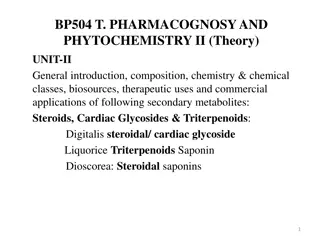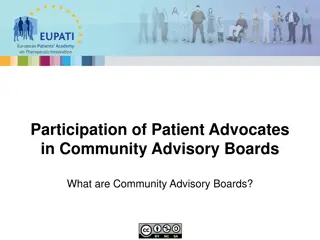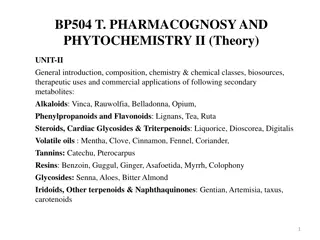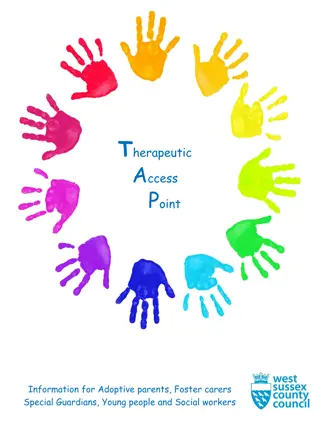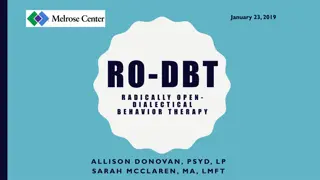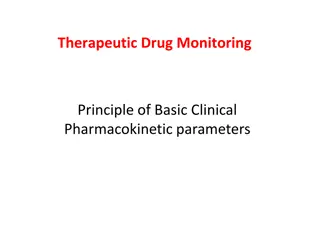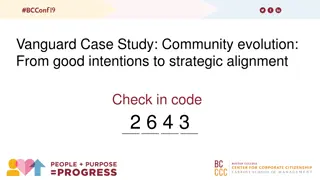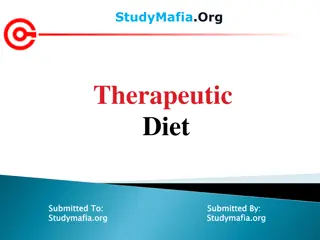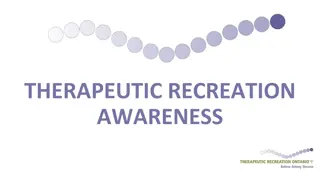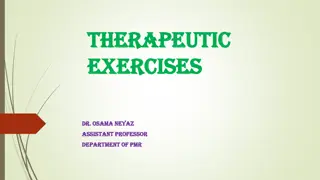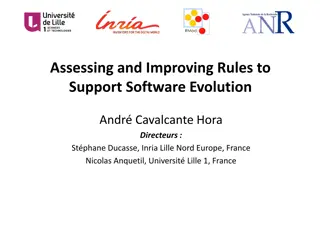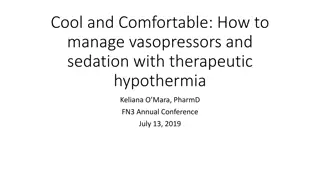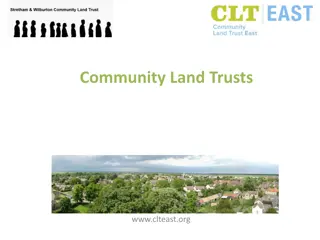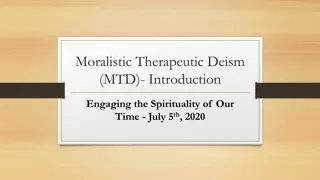Therapeutic Community: Evolution and Impact
Therapeutic communities (TCs) have a rich history dating back to 1946 when they were first utilized to address mental health issues. This treatment modality involves individuals with various conditions living together in a structured environment to promote positive change and rehabilitation. TCs have evolved over time, with different generations shaping their methods and principles. This comprehensive approach fosters community support, self-improvement, and reintegrates individuals into society.
Download Presentation

Please find below an Image/Link to download the presentation.
The content on the website is provided AS IS for your information and personal use only. It may not be sold, licensed, or shared on other websites without obtaining consent from the author.If you encounter any issues during the download, it is possible that the publisher has removed the file from their server.
You are allowed to download the files provided on this website for personal or commercial use, subject to the condition that they are used lawfully. All files are the property of their respective owners.
The content on the website is provided AS IS for your information and personal use only. It may not be sold, licensed, or shared on other websites without obtaining consent from the author.
E N D
Presentation Transcript
1 THERAPEUTIC COMMUNITY BY DR OKETE EHI . 26-04-2023.
2 OUTLINE Objectives Introduction Definition History Theories, Model and Methods of TCs Principles Examples of therapeutic communities Advantages /Disadvantages Outcomes Day treatment Conclusion Reference
3 OBJECTIVES To understand the concept of a therapeutic community.
4 INTRODUCTION Therapeutic community as treatment modality is used in variety of populations and settings including people with substance use disorder, Individuals with special needs, individuals with psychosis, correctional centres ,personality disorders etc. This community treatment participants to work with one another, through their daily routine thereby promoting self change and becoming positive role models to one another. model encourages
5 CONTD. It is a range of treatment traditions and approach that uses the relationship residents within the TC to aid therapeutic task. Recent programs have professionals (e.g. consultant psychiatric nurses, psychologist) as staff offering medical services in the therapeutic community. and activities of medically trained psychiatrist workers , social and
6 DEFINITION A therapeutic community is a drug free environment where individuals with substance use disorder live together in an organized and structured way to promote change towards a drug free life and reintegration into the society.
7 HISTORY The therapeutic community dates back to 1946. it was first used by the British psychiatrist Tom Main, during the second world war , when soldiers suffered from shell shock and war neurosis. He used group therapy on these group of individuals with successful outcome and from there the term TC was linked to group activities and relationship of residents in a residential centre. There are three generations showing how it has evolved over time.
8 FIRST GENERATION Early 1950s Described concerned with a format of therapy, in groups entails democratic procedures . This was also called the British tradition . as the democratic TC, as they were that
9 SECOND GENERATION. Began in Synanon in 1958. Founded by a recovered alcoholic, named CHARLES CHUCK DEDERICH. It was set up as a utopian Idealistic microsociety where recovering individuals with SUD lived and worked together, adhering to values creativity, openness and self reliance . It involves the US tradition . such as truth, honesty ,
10 THIRD GENERATION . From late 1960s to 1980s. The beginning of the third generation TCs occurred when heroine addiction emerged in several European countries. Most European countries oriented drug treatment approach until 1990, when UK, Netherlands and Switzerland reduction approach in reducing negative health and social consequences of drug use . applied an abstinence embraced the harm
11 CONTD. In 1990s, the TC started facing challenges of financial setbacks from economic crises , increased rates of drop outs and relapse figures. These challenges contributed to the decrease in number of TCs in some of these countries . More recently the changing views on addiction as a chronic disorder and increasing criticism on the benefits of lengthy treatment episodes in closed residential setting have development of TCs in many countries. further challenged the
12 CONTD To cope with these challenges ,TCs have become more open towards harm reduction initiatives and several of them have scaled down to smaller or modified units. They have evolved from a long term treatment model to a shortened modified model (Modified TCs), that is tailored to the needs of specific drug users ; women with children, detainees, individuals with other psychiatric disorders .
13 THEORIES MODEL AND METHODS OF TC
14 THEORY TCs are characterized by a specific view on how to understand substance use disorder. Its seen as a problem of the whole individual, hence treatment has nothing to do with drugs but approaches the individual wholistically. Treatment highlights the belief in the residents potential and personal growth. It encourages right living(honesty, responsibility)and the consideration of learning . Recovery does not necessarily mean abstinence dedication,
15 MODEL The TC model consists of the following elements: The community environment The social organization. The work and education, TC staff members, peers and their roles in the TC, Relationships with one another, Limitations and boundaries. Obedience to authorities
16 STAGES IN A TC MODEL Typically consist of 3 stages : Induction phase:1-60 days Primary treatment phase :2 -12 months Re-integration phase : 13- 24 months
17 METHOD These are the daily regimen of structured activities and interactions contributing to recovery. These activities involves : Daily community meetings Seminars Encounter groups and Other therapeutic sessions.
18 PRINCIPLES The therapeutic community works on clear principles that provides a safe environment for the exploration of difficult issues. These principles includes Communualism Permissiveness Reality Confrontation Democracy
19 EXAMPLES OF THERAPEUTIC COMMUNITIES .
20 EXAMPLES DATER ,FNPH USELU Aro hospital, Abeokuta Meville health , Gwarimpa , Abuja . Antinarcotics Revolutionary Chaplaincy , Abuja. House of refuge , lekki , Lagos CADAM rehabilitation centre , Epe ,Abeokuta . Synanon California residential rehabilation community ,
21 Components of DATER Unit, Uselu Computer room Review room Recreational room Library Kitchen Bedrooms for males and females
22 Activities in DATER unit , FNPH Uselu. Community meetings Counselling sessions Psychological therapy (Individual and group therapy ) Recovery meetings/educational sessions. Recreational activities Patient govt /ward council Sessions with the chaplain Occupational therapy. Cooking sessions
23 Community meetings(DATER) Facilitator present News correspondence Pull ups Affirmation Concept Up rituals : jokes, wise sayings ,riddles, poems, songs
24 ARO THERAPEUTIC COMMUNITY It started at the lantoro annex which was a colonial local government prisons until it was transformed into an asylum, to accommodate and provide care for the mentally ill soldiers during the second world war. It was overseen by a medical colonial psychiatrist (Dr Cameron) took over full time work at Lantoro. Much later, it accommodated civilian patients and became a well equipped mental health hospital. Late Professor T.A Lambo took over from Cameron as the 1stNigerian psychiatrist who introduced the village colonial officer until the first
25 CONTD The ARO therapeutic community accommodated several patients with different mental health conditions and were managed within nearby villages by nurses for about 3 5 months before they were judged mentally fit to return back to work. Currently they offer services outreaches ,community residential service, community partnership mental health day services . such as and : community rehabilitation community service,
26 ADVANTAGES Gain self confidence Develop leadership skills Learn to understand and solve the problems of others . Socio centric Learn to think and live collectively with other members of the community .
27 DISADVANTAGES Role blurring between the staff and patient Group responsibility responsibility Individual needs and concerns may not be met Some clients may find it difficult to adapt within the community. can easily become nobody
28 OUTCOMES This is dependent on the length of stay( treatment duration) and level of activites . Those who complete treatment outcome than who drop out of the programme. involvement in community may have better
29 DAY TREATMENT. This is the out patient programme or day care treatment which is traditional residential model. It has increased in acceptability over the years as its a convienient approach for the client ,especially those with less severe social problems to address . an alternative to the and cost effective
30 CONCLUSION. Therapeutic communities has role to play in the future of mental health services . There s need for a more equitable and appropriate service provision in the community, to address unmet needs in the population with regards to mental health.
31 REFERENCES Vanderplasschen. communities for treating addictions in europe; evidence,current practices and future challenges. 2014. Kaplan, H.I, Sadock, B.J & Grebb, J.A(2015). Synopsis of psychiatry 11th ed. Vanderplasschen W. Colpaert K. Autrique M. Charles Rapp R. Pearce S. Broekaert E. and Vandevelde S. addictions : A review of their effectiveness from a recovery oriented perspective. The scientific world journal, vol 2013. W, Vandevelde. S, Broekaert. E. Therapeutic Therapeutic communities for https://nida.nih.gov/publications/research-reports/therapeutic-
32 THANK YOU


